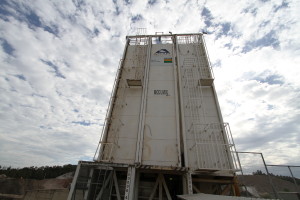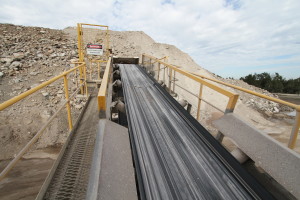The history and origination of the Continuous Mixer began in the mid 1980’s.
Aran was founded on a solid focus of excellence in engineered solutions. This is not only apparent in the robust design of the equipment, but a collaborative scientific approach to developing industry standards and construction methods. One example of this is the development of a rationale and equation to objectively measure the effectiveness of mixer types for mixing cementitious materials.
1985, Dutch Stephenson, founder and owner for Stephensons Construction of Washington, bought the second Aran ASR200 mobile pugmill to be used in the USA. Dutch was a pioneer in mixing RCC and CTB, with his first project at the Burlington Northern Railroad in Denver. RCC was still in its infancy in 1985, with some contractors attempting to produce RCC with inadequate equipment. Some projects were poorly completed. It was necessary to prove that the Aran pugmill and material metering feeders had the accuracy and mixing effectiveness necessary to produce a quality RCC mix. Collaborating with Aran and the Portland Cement Association (PCA) Stephenson tested the Aran pugmill in Tacoma, WA with several mix designs. The testing proved the Aran plant could not only produce RCC, but also various traditional designs of slump concrete. Stephenson raised the challenge to Aran to develop a plant primarily focused on Concrete.
In 1986 Aran released the ASR280C (C for Concrete) mobile pugmill. This machine included many new features to improve its capability of material dosing and mixing concrete. These features included a larger cement metering feeder with negative pressure silo, improved aggregate hopper and metering feeder and most importantly, the mixer with a new blade phasing arrangement and various other flexible operating features. To prove the new design Aran invested in ~$300,000 testing program at the Monnier Hard Rock Quarry in Redbank, QLD Australia. Construction Testing Pty Ltd of Brisbane were engaged in June 1986 to test materials produced by the new Aran ASR280C pugmill. The results were also reviewed and ratified by Golder Associates.
Testing included the following samples:
10-30mpa Pavement Type Concretes to assess the following plant performance metrics:
- Consistency of mix over time, collecting material at 40 second intervals from the start to the end of a production cycle (Batch).
- Consistency across the mixer and discharge belt from batch to batch. Samples taken at the centre and each edge of the static belt.
- Consistency – short run reliability of mix at 15 second and 30 second batch run intervals.
- Air Entrainment evaluation with samples taken at 10, 20, 30 then 15 sec intervals over 90 second total sample production runs, at 10-30mm slump and 50-60mm slump.
- Water Reducing agent evaluation with the same intervals.
A large database of records collect confirmed that Aran ASR280C:
- Demonstrated uniformity of cement feed, whilst the silo was being filled and at various levels.
- Demonstrated sufficient mixing time and mixing thoroughness by material testing and using colour additives
- Demonstrated effectiveness of admixtures
- Slump uniformity
During the trials, Aran tested several mixing blade phasing patterns, blade angles, mixer shaft speeds and entire mixing chamber angles. Some adjustments to mechanical or operational characteristics made very little difference, others made a significant difference in mix quality.
On the strength of these positive test results, Dutch Stephenson ordered another Aran machine, an ASR280C delivered in September 1986.
These testing program results aroused elevated interest in the unique Aran pugmill design and its capacity to produce high quality product, at high instantaneous production rates. It was important to prove the Aran pugmill credentials, differentiating it from other mixing systems traditionally employed.
In October 1986, Trevor Dunstan developed, what is now known at the Mixer Effectiveness Equation or Mixer Effectiveness Index (MEI). Written as an appendix to his white paper titled “Continuous Volumetric Metering of Concrete Ingredients, The Aran Equipment Approach to Accuracy – How it Works”. This paper was presented at various conferences and industry meetings in Australia, USA, China and Europe during the remainder of the 1980’s and early 1990’s. The MEI was later updated in 2006 to include other input data necessary to give a reliable measure for applications when mixers are processing slurries and clays. The original Mixer Effectiveness Index is still used by many designers and contractors today.








